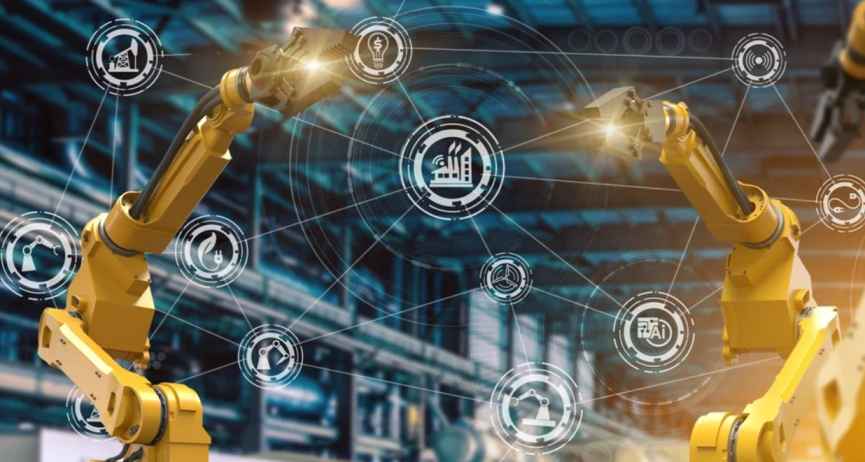Imagine stepping into a futuristic factory where machines chat and adapt in real-time. Welcome to the world of Industrial IoT (IIoT), where analytics are not just tools but the lifeblood of business success. In this post, we’ll dive into the fascinating journey of IIoT analytics and its transformative power.
The Promise of IIoT: Beyond Basic Connectivity
Understanding IIoT’s Role in Operational Optimization
Have you ever wondered how industries are evolving with the Internet of Things (IoT)? The Industrial Internet of Things (IIoT) is more than just connecting devices. It’s about optimizing operations and driving efficiency. Imagine a factory where machines communicate with each other, sharing data in real time. This is not just a dream; it’s a reality with IIoT.
- Streamlining Processes: IIoT enables manufacturers to monitor equipment health, predict failures, and maintain optimal performance.
- Reducing Costs: By using data intelligently, organizations can minimize wastage and improve resource allocation.
- Identifying Opportunities: With actionable insights, businesses can explore new revenue streams that were previously overlooked.
Examples of How Connected Devices Stream Data
Connected devices are busy gathering data every second of the day. Think about how these devices work.
- In automotive manufacturing, sensors on production lines monitor every aspect of vehicle assembly, ensuring quality control.
- In electronics, real-time analytics assess product quality during assembly, so defects are caught early.
- Consider smart meters in energy consumption. They provide insights on usage patterns, allowing for better energy management.
These examples illustrate the power of streaming data. When devices communicate effectively, they create a symphony of operational intelligence. You can make decisions based on real-time data rather than relying on outdated reports.
The Leap from Anecdotal to Actionable Insights
IIoT transforms vague notions into concrete actions. Think about it: when you have data at your fingertips, every decision becomes informed. But how do you turn numbers into strategy?
- Data Democratization: Empower all employees, not just data scientists, to understand and interact with data.
- Using Analytics: Implement tools that visualize data trends and anomalies for swift decision-making.
- Achieving Efficiency: Deploy insights rapidly to enhance productivity and reduce delay.
Looking Ahead: The Data Explosion
Consider this staggering data: it was reported that by 2020, an amazing 30 billion devices were expected to be connected, generating over 163 zettabytes of data by 2025. That’s an enormous leap in how much information we have to work with!
| Year | Connected Devices | Data Volume |
|---|---|---|
| 2020 | 30 billion | |
| 2025 | 163 zettabytes |
This massive influx of data presents both challenges and opportunities. The key is leveraging analytics to turn this data into actionable insights. As we navigate through these changes, it’s clear that embracing IIoT isn’t just beneficial—it’s essential for any industry looking to thrive in this new landscape.
Overcoming the IIoT Hurdles: Skills and Technology
As industries evolve, the skills gap in the workforce becomes increasingly apparent. Many companies grapple with the shortage of skilled data scientists. This gap poses a significant hurdle for organizations hoping to harness the power of the Industrial Internet of Things (IIoT). You may be asking, how can companies bridge this gap effectively?
Identifying the Skills Gap
The first step is to identify the skills lacking within your organization. Are your employees overwhelmed by data? Do they struggle to make informed decisions? Perhaps they need training in data analysis or understanding analytics tools. Recognizing these gaps helps pinpoint where to focus resources.
Strategies to Develop ‘Citizen Data Scientists’
One effective strategy is to develop what are called “citizen data scientists.” These are everyday employees who can interpret data and generate insights, without necessarily having formal data science training. By empowering your existing workforce:
- Offer training sessions on data analysis tools.
- Implement mentorship programs with skilled data scientists.
- Encourage collaboration between teams to foster knowledge sharing.
By investing in your employees, you create a culture of analysis and innovation.
Navigating Large-Scale Data
The IIoT generates massive amounts of data. Companies often face challenges from this data overload. Do you feel overwhelmed by vast data lakes? Implementing user-friendly tools to simplify data analysis can provide relief. Here are some examples:
- Data visualization platforms that make trends visible.
- Cloud-based analytics tools that handle large datasets effectively.
3 Pillars of Effective IIoT Analytics
In a rapidly evolving industrial landscape, understanding IIoT analytics is vital. There’s a wealth of data generated by connected devices. The question is: How do you harness this data effectively? The answer lies in three key pillars: democratizing data, the edge-through-cloud model, and visualizing data.
1. Democratizing Data for Broader Access
Data should not be locked away in silos. What if everyone in your organization could access and analyze the data they need? When you democratize data, you empower each level of your company.
- Increased transparency leads to trust.
- Employees can make data-driven decisions on their own.
- Fosters a culture of continuous improvement.
2. The Edge-Through-Cloud Model Explained
The edge-through-cloud model is transformative. It combines the speed of edge computing with the scalability of cloud. Imagine processing data close to the source—at the edge—while keeping the cloud as a backup for more extensive analysis. This dual approach allows for:
- Faster responses to real-time events.
- Reduced latency for critical applications.
- Efficient data management and storage.
This model sets the stage for effective IIoT analytics, maximizing operational insights.
3. Visualizing Data for Rapid Decision-Making
Data visualization tools help you see what is happening at a glance. Do you ever feel overwhelmed by spreadsheets filled with numbers? Visuals transform complex data into easily digestible graphics. Here are some benefits:
- Faster comprehension of trends and patterns.
- Quicker identification of issues before they escalate.
- Enhanced collaboration across teams.
By visualizing data, you empower everyone in your organization to make informed decisions swiftly.
By focusing on these three pillars, organizations can see significant improvements in key performance indicators (KPIs). These improvements may include a notable increase in production yield and a reduction in energy consumption. As industries lean into digital transformation, understanding how to utilize these pillars effectively becomes essential for success.
Real-World Applications: IIoT in Action
Have you ever wondered how advanced technologies are reshaping industries? The Industrial Internet of Things (IIoT) is leading that charge. With its ability to connect countless devices, IIoT offers a treasure trove of data that can optimize operations and reduce costs. Let’s explore some real-world applications that showcase the power of IIoT.
Case Studies in the Automotive and Electronics Industries
In the automotive sector, predictive analytics is changing the game. For example, manufacturers use predictive models to minimize paint defects. Before IIoT, these issues were often identified too late. Now, real-time data enables immediate adjustments. It’s like having a mechanic in your car who alerts you when something’s not right.
Similarly, in the electronics industry, companies are harnessing IIoT to boost yields in printed circuit board manufacturing. This process involves constant monitoring of production lines. By analyzing data in real-time, manufacturers can make informed decisions on quality control. The result? Increased efficiency and reduced waste.
Predictive Analytics: Solving Real Problems
- Identify trends quickly – The use of streaming analytics helps monitor sensor data, detecting anomalies as they happen.
- Optimize resources – Many organizations have improved their key performance indicators (KPIs), such as production yield and energy consumption, through data-driven decisions.
“Real-time insights change the game for manufacturers,” says an industry analyst. This shift not only reduces operational costs but opens new business opportunities through better insights.
Visual Storytelling Through Data
Data on its own can be overwhelming. That’s where visual storytelling comes in. Using charts and graphics, industries can transform complex data into digestible information. Imagine seeing a simple graph that shows how adjustments in a production line directly improve your bottom line. It’s compelling and effective.
In essence, the deployment of IIoT and streaming analytics significantly empowers industries. The results are tangible and backed by quantifiable improvements.
However, every journey has its challenges. Many organizations struggle with the scaling of IIoT projects. Understanding the business implications rather than just the technology is critical. Having a clear strategy can lead to overcome these hurdles and fully utilize IIoT’s capabilities.
Looking Ahead: The Future of IIoT and Analytics
Emerging Trends to Watch in IIoT
The Industrial Internet of Things, or IIoT, is reshaping the way industries function. But what exactly should you look out for? Here are a few emerging trends:
- Increased Connectivity: By 2025, it’s estimated that 163 zettabytes of data will circulate, driven by 30 billion connected devices.
- Simplified Data Analysis: The rise of “citizen data scientists” will empower more employees to interpret data without needing deep expertise.
- Predictive Analytics: More industries will use data to forecast potential issues before they arise, enhancing operational efficiency.
The Integration of AI with IIoT Analytics
How can AI amplify the power of IIoT? Essentially, artificial intelligence can analyze vast amounts of data quickly and accurately. The result? Actionable insights that businesses desperately need.
“The intersection of AI and IIoT will pave the path for innovation” – Tech Futurist. This quote beautifully captures the synergy between AI and IIoT.
AI allows for real-time data processing. This means immediate decisions can be made to enhance operational reliability. Imagine being able to fix an issue before it disrupts your production line!
The Evolving Landscape of Data Compliance and Ethics
With great data comes great responsibility. The growing focus on data compliance highlights ethical implications surrounding the collection and use of data.
- Transparency: Organizations will need to be clear about how they collect and use data.
- Security: Protecting sensitive information is crucial to foster trust among clients and partners.
As industries continue to evolve, prioritizing data ethics will not just be a good practice; it will become a necessity for long-lasting success.
Future Predictions for IIoT Adoption
Looking to the future, what will IIoT adoption rates look like? It’s a safe bet that industries will increasingly embrace this technology. The innovative potential it unleashes cannot be ignored. The right approach to implementation will unlock unprecedented levels of efficiency and insight.
As you can see, analytics will remain a cornerstone of the IIoT landscape. They will be vital in making sense of the vast volumes of data generated.
Bottom Line
In conclusion, the future of IIoT and analytics is bright. Whether through emerging trends, the fusion of AI capabilities, or the keen awareness of ethical practices, companies that adapt swiftly will thrive. By keeping an eye on the evolving landscape, organizations can harness the true power of IIoT, turning data into actionable insights and driving strategic advantages across multiple industries. The road ahead is filled with opportunities, and the key lies in successfully navigating them with informed analytics and ethical practices.
Recommended Reading:




2 thoughts on “Harnessing the IIoT Revolution: Transformative Analytics for the Future”